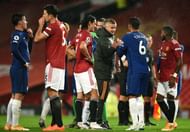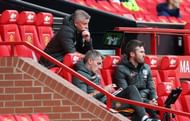
Manchester United played out a drab 0-0 draw on Saturday against Chelsea at Old Trafford. Both managers seemed content with the result at the full-time whistle. But looking back, it certainly feels like a step back for United after what they did against Newcastle and PSG in the previous week.
Why did Manchester United fail to break down Chelsea’s vulnerable defense?
It is quite evident now that this Manchester United squad is able to sit deep and attack on the counter. It won’t be wrong to say that this is Manchester United’s default strategy against most teams. On the other hand, Frank Lampard’s ongoing struggle to improve his defense is well known, and he lost to United on three occasions last season.
Lampard learned his lesson, and when the two sides met again in the FA Cup semi-final, he set up his side with a back three that didn’t allow Manchester United’s frontline any space to run into. It worked. On Saturday, Lampard set up his side similarly and was successful in nullifying United’s attack.
Solskjaer’s plan was clear - use Daniel James and Marcus Rashford’s pace to get behind the Blues' defense. Harry Maguire, Scott McTominay and Fred launched diagonals various times on the left side to James, but Chelsea’s backline didn’t give him much space.
Manchester United's attacking and defensive limitations

Manchester United created 12 chances against Chelsea on Saturday, none of which was a ‘big chance’. In all of their previous league games this season, they have had at least one. From what we have seen so far, it’s clear that Manchester United haven’t been able to play with the fluidity that defined them post-lockdown.
There is a joke doing rounds that Manchester United's best tactic is to win a penalty and let Bruno Fernandes do the rest. The win against Brighton might have given them three points, but Solskjaer's side were far from convincing in attack.
Manchester United's defense was heavily criticized even after their opening two games, but things reached a low point during the 6-1 hammer blow at the hands of Tottenham Hotspur.
Manchester United's defensive performance has markedly improved after the international break. However, there were still some twitchy moments, like Luke Shaw’s freakish own goal at St. James’ Park or Anthony Martial’s own goal at the Parc des Princes.
Can Solskjaer address these issues?
Manchester United have shown inconsistency in attack and defense so far this season. Solskjaer’s men lack cohesion on the field.
The best managers don’t rely on any particular aspect, no matter how superior it may be. Everything needs to happen in unison on the pitch. Solskjaer needs to work on defensive solidity and attacking cohesion. Unlike last season, the Norwegian is yet to sort out his best XI.

However, there have been encouraging signs after the recent international break. Solskjaer prefers to set up his team in a 4-2-3-1 system. He introduced Fred and Scott McTominay instead of Nemanja Matic and Paul Pogba to play the double pivot after the international break. Fred and McTominay may lack the experience and skill set that Pogba and Matic offer, but they provide certain balance and control to the side.
The Brazilian possesses a decent passing range while the Scotsman wins a fair amount of tackles and aerial duels. Although their collective weakness is creativity, Solskjaer can overcome that by fielding another creative player along with Bruno Fernandes, ahead as he did against Newcastle with Juan Mata.
However, Mata is 32 and may not possess the physical attributes to play every game. Mason Greenwood is most likely to be restored to that position once his niggling injury problems are over.
Besides, there is a growing sense of frustration among supporters regarding the new signing Donny van de Beek. The Dutch midfielder is yet to start a league game. The 23-year-old has shown that he can be incisive on the field in the appearances he’s made so far off the bench.
Van de Beek’s best position is either a free no. 8 on the left side or a pure no. 10. In Solskjaer’s preferred set up, neither position is up for grabs. But van de Beek could be played on the right flank as Mata did against The Magpies. This would allow the Dutchman to link up with Fernandes and other United attackers. He can also drop deep when required and offer some defensive protection.
Solskjaer has played different combinations this season, some due to injuries and suspension and others due to tactical reasons. He’s got more quality options that could provide a bit of defensive stability and attacking fluency, and instill a sense of unpredictability among oppositions. He will need to figure out his best XI soon if Manchester United are to challenge for trophies this season.
